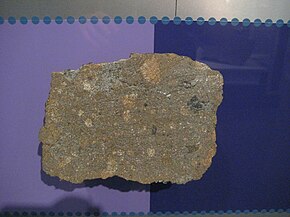

| Weston meteorite | |
|---|---|

Weston meteorite, H4
| |
| Type | Ordinary Chondrite[1] |
| Class | H4 |
| Weathering grade | W0 |
| Country | United States |
| Region | Fairfield County, Connecticut |
| Coordinates | 41°13′N 73°23′W / 41.217°N 73.383°W / 41.217; -73.383 |
| Observed fall | Yes |
| Fall date | 14 December 1807 |
The Weston meteorite is an H4 ordinary chondrite meteorite which fell to earth above the town of Weston, Connecticut on the morning of December 14, 1807.[2]
The Weston meteorite fell to earth above the town of Weston, Connecticut at approximately 6:30 in the morning on December 14, 1807.[2] The meteor fall was widely witnessed[3] and reported in newspaper accounts at the time.[4] Eyewitnesses reported three loud explosions with stone fragments falling in at least six locations.[5][6]
Currently none of the strewn field (the debris field where the bulk of the fragments fell) was located on is in the town of Weston, but is primarily located in neighboring Easton. In 1807 the land that would later become the town of Easton was within and part of the town of Weston, hence the name Weston meteorite.
The majority of the debris field is located in the eastern part of the present day town of Easton - in and around the Easton Reservoir.[4] The remaining part of the debris field extended into the western part of neighboring Trumbull. Several fragments of this meteorite were collected in the Tashua section of Trumbull, in and around what is now Sturbridge Lane and Tashua Knolls.[4]
Fragments from the fall were collected, documented, and chemically analyzed by Yale University professors Benjamin Silliman and James Luce Kingsley. The Weston meteorite is the first meteorite to fall in the New World which was documented in such a manner, marking the beginning of meteorite science in the United States. Fragments of the meteorite remain within the Yale meteorite collection, which is the oldest such collection in the United States.[4]
The meteorite was also written about, at the time, by Nathaniel Bowditch, calculating the size and trajectory of the meteor.
Coordinates that best express the Weston fall are 41°16'N, 73°16'W (see new publication by Robson and Pagliaro 2009). The Weston meteor was observed for approximately ten seconds at 06:00 Eastern Standard Time (11:00 UTC) on 1807 December 14 over New York state and New England. The meteor's atmospheric trajectory was on a course of 155 degrees azimuth (NW to SE) at a slope to the horizon of 30 degrees. The meteor became visible at an altitude of approximately 84 km and its terminal point was at an altitude of approximately 16 km. A significant fragmentation of the meteoroid occurred in the vicinity of New Milford, Connecticut at an altitude of 30 km. Upper air winds distributed the seven fragments recovered into a classical elliptical pattern (centered on the above given coordinates); the major axis being 12 km and orientated north to south. The total mass is ~20 kg. The main mass landed on a rock outcropping in a pasture in Easton, Fairfield County, Connecticut, within 100 m of 41°12'50" N and 73°15'43"W.
Suddenly the heavens above [Judge Nathan] Wheeler's farm exploded as a fireball raced across the onyx sky. Everything lit up—his home, his barns, the trees, the blue stone walls.
On December 14, 1807, a widely witnessed meteorite fall over Weston, Fairfield County, Connecticut, brought the new science of meteoritics to the United States. Recovered, documented, and chemically analyzed by Yale University professors Benjamin Silliman and James Kingsley, the Weston meteorite became the first such scientifically verified meteorite fall in the New World. Fragments collected by Silliman and Kingsley were the first catalogued objects in the Yale meteorite collection, the oldest such collection in the United States. News reports of the day and subsequent inventories suggest that there were several dozen fragments, which have a combined mass of ~ 150 kg. The Weston meteorite is an H4 ordinary chondrite
Two or three days after the fall, Professor Benjamin Silliman heard of it and - with Professor James L. Kingsley - immediately went to Weston to investigate. [...] After reading the report by the two professors, President Thomas Jefferson reputedly exclaimed: "It's easier to believe that two Yankee professors would lie than that stones would fall from heaven!"
Fragments of the exploding stone had rained about the town, and one large piece struck not two rods distant from the Prince house. This intrepid family, upon discovering the treasure that had buried itself in their front yard, promptly dug it up and smashed it apart, discerning, with a sense of true Yankee economy, that if one stone could be valuable, many were more so.
|
| |||||||||||||||||||||||
|---|---|---|---|---|---|---|---|---|---|---|---|---|---|---|---|---|---|---|---|---|---|---|---|
| Meteorite... |
| ||||||||||||||||||||||
| Classification |
| ||||||||||||||||||||||
| Mineralogy and petrology |
| ||||||||||||||||||||||
| Lists |
| ||||||||||||||||||||||
| |||||||||||||||||||||||
|
Meteorites by name
| |
|---|---|
| A–B |
|
| C–D |
|
| E–F |
|
| G–H |
|
| I–J |
|
| K–L |
|
| M–N |
|
| O–P |
|
| Q–R |
|
| S–T |
|
| U–V |
|
| W–X |
|
| Y–Z |
|
| |